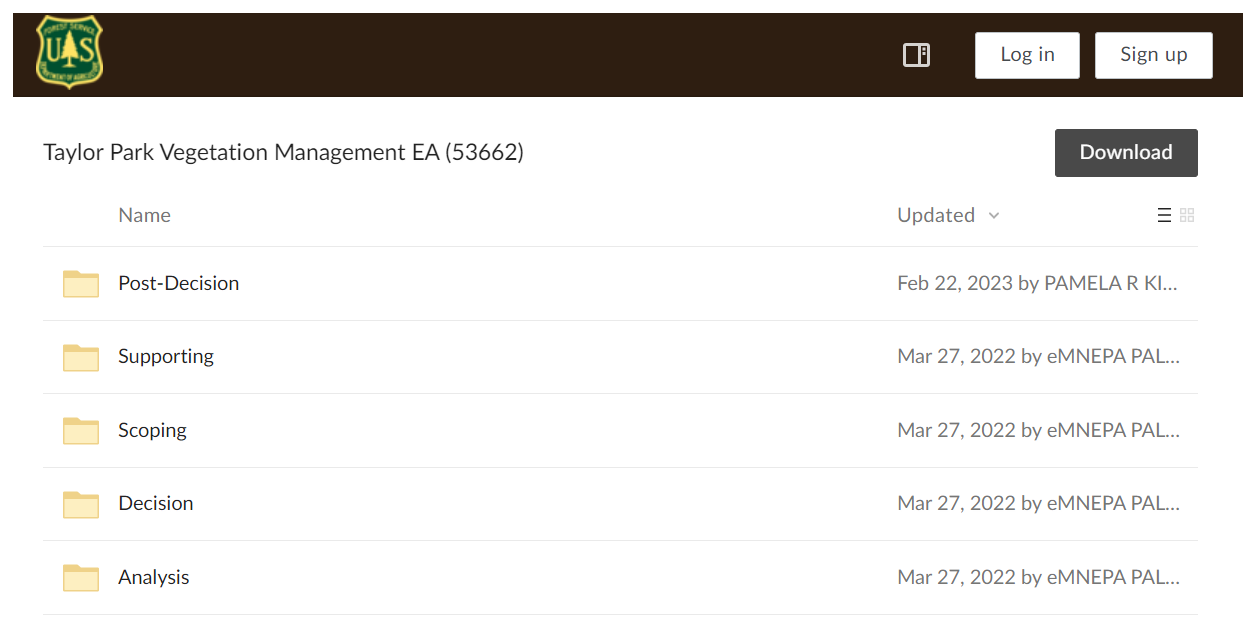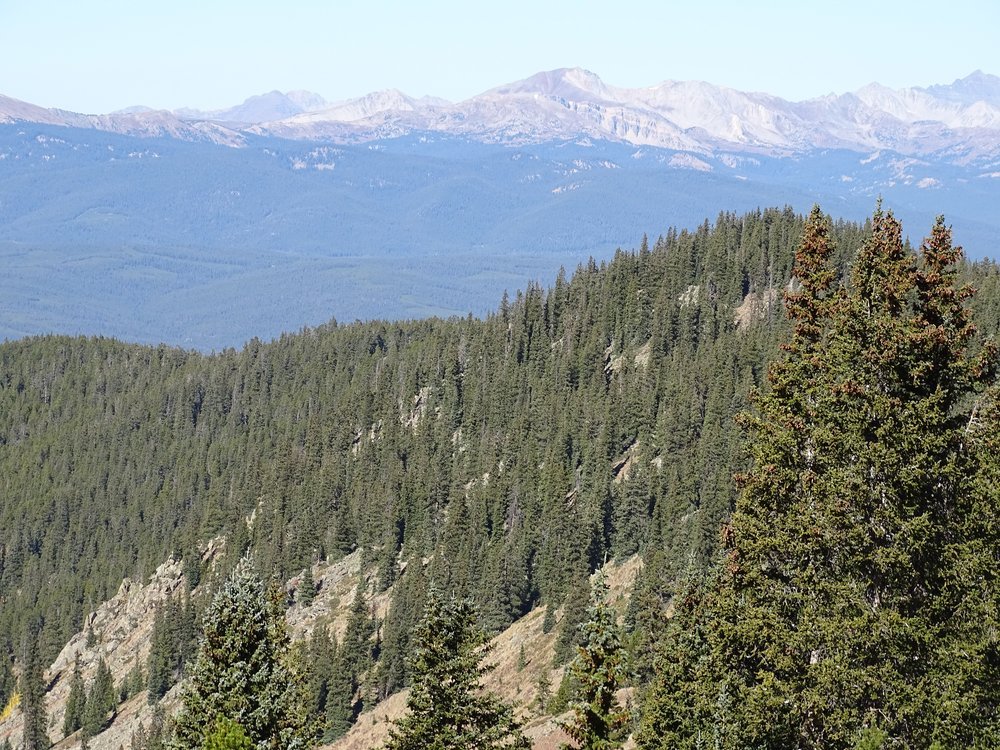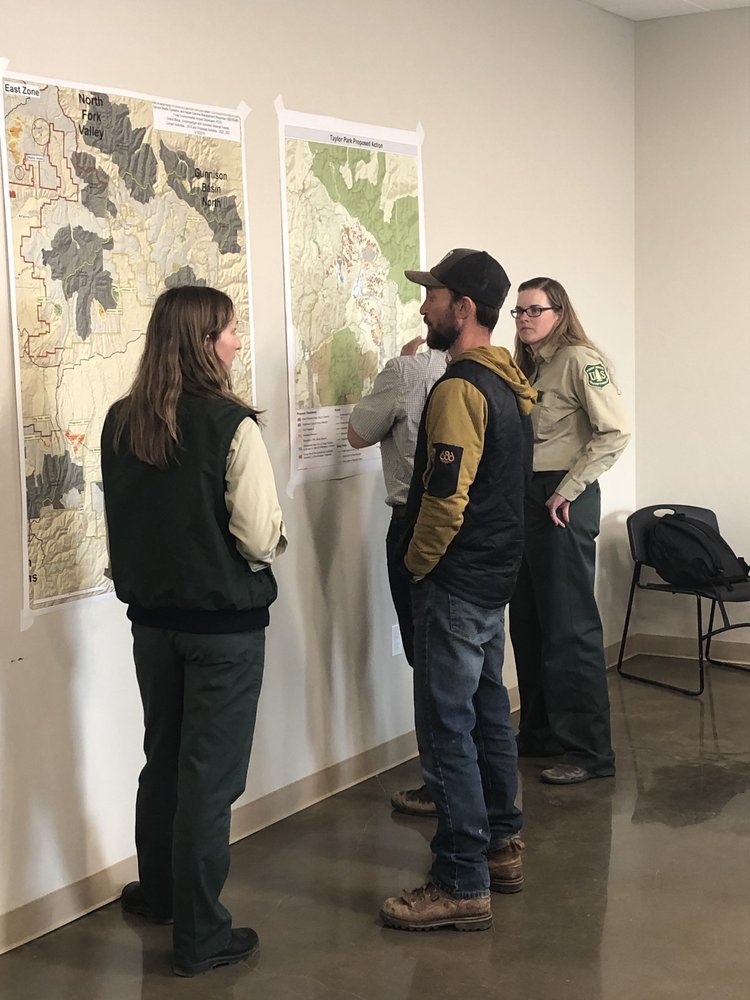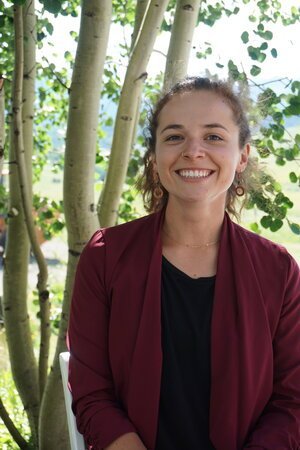Taylor Park Vegetation Management Project
For an interactive map showing the most current 3-year timber sale plan, please refer to the SBEADMR and Taylor Park Story Map. This map will be updated annually. It also serves as a comment platform during our annual 30-day public comment period (generally during late February/March).
Western Colorado University’s Center for Public Lands collaborates with the Gunnison Ranger District of the Grand Mesa, Uncompahgre, and Gunnison National Forests in the facilitation of an adaptive management group and University-affiliated Science Team to compliment the Taylor Park Vegetation Management Project.
The Taylor Park Vegetation Management Project is anticipated to be a 10-year project to increase forest resilience and provide wood products for the local economy. Approximately 20,000 acres of lodgepole pine and Engelmann spruce forests in the Upper Taylor River and Spring Creek drainages will be treated.
If you want to be kept informed of future events, communication efforts, or have questions about the Taylor Park AMG and opportunities to engage, please email taylorparkamg@western.edu.
Taylor Park is located in the north-central portion of the Taylor Basin, west of the upper Taylor River and south of Trail Creek on the Gunnison Ranger District of the Grand Mesa, Uncompahgre, and Gunnison (GMUG) National Forests. This area is composed of a mosaic of mature forests, regenerating clearcuts, and regeneration from a 1980’s wildfire in the uplands. Meadows and fens occupy lower landscape settings. Forests are composed of lodgepole pine (Pinus contorta) with a very minor component of Engelmann spruce (Picea engelmanii) and subalpine fir (Abies lasiocarpa).
Summer 2024 AMG Updates
The most recent SBEADMR and Taylor Park Vegetation Management Annual Stakeholder Meeting occurred on Thursday, February 15, 2024. View presentations and/or watch the recording here!
The AMG met soon after to go through an exercise to evaluate project design criteria for work currently being implemented, which they will put to use in preparation for our next annual field trip.
Have questions about the Vegetation Management Project, or want to be involved? Please email taylorparkamg@western.edu! We’re specifically seeking representation from those in the recreation/outfitting and mining industries.
We are similarly interested in those who would like to engage with a public outreach-focused subgroup!
-
During agency scoping, the local community expressed a desire to develop an adaptive management group (AMG) specific to the Taylor Park project to amplify and formalize public engagement throughout the life of the project. The Gunnison Ranger District was responsive and partnered with Western Colorado University’s Center for Public Lands for the development and facilitation of the AMG.
-
In early 2019, Western hosted several workshops to give the public an opportunity to learn more about the Taylor Park project and initiate a stakeholder engagement process. Collectively, the workshops drew over 100 people, with attendees including Taylor Park area homeowners, wildlife biologists, outfitters, water managers, conservationists, recreationists, Western students, and forestry professionals, among others. View the workshop records here. These sessions included a “distance option” for interested members of the public to join virtually who could not attend the workshops in-person.
Topics included:
• Introduction to silvicultural practices
• Forest ecology basics
• History of forest management in Taylor Park area
These events catalyzed an initial group of self-selected, committed citizens to begin looking closely at the details of a stakeholder engagement process. Over summer and fall, this group worked with Western to:
• Refine stakeholder participation based on a balanced set of community interests
• Develop an Operations Manual defining their purpose and objectives
• Sign a Memorandum of Understanding establishing their working relationship as an AMG
Interests represented on the AMG include water resources, local government, forestry processors, state forestry officials, conservation, range, wildlife, area homeowners, outfitters, local business, forestry loggers, recreation, and mining.
-
The Taylor Park AMG is modeled from an ongoing landscape-scale project on the GMUG titled the Spruce Beetle Epidemic and Aspen Decline Management Response (SBEADMR).
SBEADMR also works with an AMG, brought together a Science Team, and takes an adaptive management project approach.
Supplemental Documents:
2023 Science Team Monitoring Matrix
The AMG is an inclusive and balanced stakeholder group working to share knowledge of social, economic, and ecological condition and desired conditions within the Taylor Park Vegetation Management Project. The group brings together members of the public, private landowners, local government, businesses, ranchers, water users, conservationists, recreators, and land managers to identify concerns, questions, obstacles, and opportunities raised throughout the life of the project.
The project area contains abundant populations of the mountain pine beetle, spruce beetle, and dwarf mistletoe, as well as heavy fuel loading — all of which present risks relevant to wildfire incidence and intensity, generation of forests products, and overall forest health. Forests will be treated using commercial harvest, non-commercial harvest, and prescribed fire treatments as appropriate to the site-specific situation.
This project has been designed under an adaptive implementation framework. The AMG and Science Team have worked together with the Forest Service in the Environmental Assessment project design and currently remain engaged in the implementation process.
-
Adaptive management is a structured, iterative process.
It is based on learning through partnerships and collaboration. Adaptive management acknowledges that conditions can change between project planning and implementation and allows decisions and actions to be re-evaluated based on ground-level conditions.
An adaptive management approach includes designing and executing actions, then monitoring the efforts to learn and adjust future management actions toward the goal of improving management effectiveness.
Natural resource management is complex because decisions affect not only ecological systems, but also social, economic, and other values in nearby communities. Collaborative problem-solving processes, such adaptive management, bring together people who understand the issues, have a stake in their outcomes, and gives them an opportunity to weigh in on decisions.
-
In the spring of 2018, the agency proposed the project and public involvement began. The Forest Service issued a scoping letter to determine the extent of the issues needing consideration and analysis as the Environmental Assessment (EA) was being developed.
In addition, a public meeting was held in Tincup, Colorado in the spring of 2018 to present the proposed project to interested members of the public and solicit comments. At that meeting, local stakeholders expressed a strong desire to develop a Taylor Park specific Adaptive Management Group to amplify and formalize public engagement in development of the project.
In response to this request, the Gunnison Ranger District of the Grand Mesa, Uncompahgre, and Gunnison National Forests entered into an agreement with Western Colorado University’s Center for Public Lands for the development and facilitation of an adaptive management group and University-affiliated Science Team.
In early 2019, Western hosted several workshops to give the public an opportunity to learn more about the Taylor Park project and initiate a stakeholder engagement process. These events catalyzed an initial group of self-selected, committed citizens to begin looking closely at the details of a stakeholder engagement process.
-
In the spring of 2019, a Preliminary Environmental Analysis was published, and a 30-day comment period began. The resulting public comments included requests to modify elements of the proposed action, including three main areas of concern: temporary roads, watershed health, and economic viability of potential commercial timber sales.
A meeting was held with the agency and AMG members to discuss the comments and proposed actions. At this meeting, it was determined the agency would collaborate with the Science Team to develop a new alternative informed by comments from the public and AMG. All meetings were public and available for distance participation.
In the summer of 2019, a public field trip was held to provide a learning opportunity about proposed treatments, examples of poor forest health, and desired forest health conditions.
Later in September 2019, a meeting was held to review the working draft of the New Alternative (Alternative 2) and propose the addition of prescribed fire to the project.
The Forest Service and Science Team presented the New Alternative to the AMG and public in September 2019 and again, in more detail, in December. In response to requests at the December meeting, the agency made portions of the draft New Alternative materials available to the public and provided another opportunity for informal review and feedback. That feedback was reviewed in discussed in February 2020.
-
Alternative 2 was generated from comments presented during the preliminary environmental analysis comment period, meetings with the Taylor Park AMG, interested stakeholders, and the Science Team.
A draft Decision Notice/Finding of No Significant Impact was prepared by the Gunnison District Ranger in February 2020 and subject to a 30-day administrative review (commonly known as the objection process). Three objections were received and reviewed by a team of agency specialists outside the Gunnison Ranger District. To address these objections, the a component of the project known as Contingency Treatment Areas were removed, and clarity was added to the watershed management objective yellow-light trigger adaptive action.
The District Ranger signed and released the final decision in June 2020, concluding the NEPA decision and beginning the implementation process. The selected alternative, Alternative 2, was generated from comments presented during the preliminary environmental analysis comment period, through meetings with the AMG and interested stakeholders, and in collaboration with the Science Team. By working together in this analysis, a future forest was envisioned in shared understanding, not just in planning, but as importantly, in a partnership for implementation and beyond.
-
The Science Team collaborates with Forest Service leadership and the AMG to ensure the project is informed by the best available science. The Science Team completes on-the-ground monitoring pertinent to questions about the project as well as cultivating an in-depth understanding of the forest structure, age class, health, and wildlife patterns in Taylor Park.
In December 2018, a specific Science Team and AMG was initiated through a partnership with Western Colorado University’s Center for Public Lands for the Forest Service’s Taylor Park Vegetation Management project. The Science Team collaborates with agency leadership and the AMG to ensure the project is informed by the best available science. The Science Team completes on-the-ground monitoring pertinent to questions about the project as well as cultivating an in-depth understanding of the forest structure, age class, health, and wildlife patterns in Taylor Park.
Science provided allows real-time monitoring to support the Forest Service in general understanding and drive changes to the project, when and where needed. This will increase understanding of treatment effectiveness in meeting stated objectives, including landscape scale reductions in fire risk and increases in forest health and resilience. This collaborative, adaptive management strategy promotes a strong working relationship between Forest Service managers, researchers, and stakeholder groups.
The Science Team began monitoring conditions in Taylor Park in the summer of 2019. Baseline monitoring includes seedling and sapling counts, tree coring, mistletoe presence and absence data collection, camera traps set for big game, small mammal trapping, and breeding bird point counts.
The Taylor Park AMG Science Team focused on three primary objectives during 2019. These included:
Completing a baseline field inventory of conditions in lodgepole pine stands in the proposed Taylor Park project area.
Conducting a public survey assessing perceptions of forest management in the area.
Working with the AMG and GMUG staff to provide information, communicate findings of interest, and facilitate the development of scientifically-informed adaptive management.
To view complete objectives and results of the Science Team's 2019 monitoring efforts, click here.
This work was supported Western's Masters in Environmental Management students Gabby Zaldumbide and Noah Hellmund's graduate research that included a preliminary survey of wildlife use in historically harvested and non-managed stands, public survey on perceptions of forest management in the area, and an assessment of fuels in the Tincup area.
View Gabby’s final project here.
View Noah’s final project here.
-
This work was supported Western's Masters in Environmental Management students Gabby Zaldumbide and Noah Hellmund's graduate research that included a preliminary survey of wildlife use in historically harvested and non-managed stands, public survey on perceptions of forest management in the area, and an assessment of fuels in the Tincup area.
View Gabby’s final project here.
View Noah’s final project here.
-
Taylor Park has been selected as a study site in the Adaptive Silviculture for Climate Change (ASCC) Network. The goals of this project are to test different silvicultural approaches to climate change adaptation that will also serve as useful examples across the U.S. and Canada.
A team of natural resource specialists from the Taylor Park region, regional managers, and scientists came together for a three-day workshop in July 2022 to develop the study design for the ASCC project site.
Monitoring and data collection are essential components of the ASCC study. ASCC incorporates a rigorous experimental design that facilitates high quality scientific assessment of treatment effects, and contrasts between different treatments. Research partners from several institutions are working together to investigate the effectiveness of different silvicultural treatments aimed at promoting ecosystem adaptations. Research questions may include:
Effects of forest thinning on tree growth and survival, particularly under future droughts and warming.
Contrasting the growth and survival of seedlings of a range of different tree species as a function of shading, microclimate, and climate variation.
Treatment effects on snow hydrology including canopy interception, snowpack accumulation and retention, soil moisture, and tree sap flux.
Responses of wildlife, insects, and understory vegetation to treatments.
-
The Taylor Park Vegetation Management Project is in the initial stages of the implementation process. SBEADMR, a project that occurs across the Grand Mesa, Uncompahgre, and Gunnison National Forests, is several years into its implementation process. Both projects use a “Plan, Do, Check, Act” cycle to link strategic plans to planning of treatments, tactical field operations, monitoring, and reporting of environmental results or problems to Forest Service management.
The interdisciplinary team completes all required surveys for a particular treatment area to ensure all resource concerns (wildlife, botany, hydrology, heritage, etc.) are known and evaluated prior to action, which then guides how best to implement both the project and the required monitoring to ensure actions and mitigations applied are effective.
An implementation checklist is used to document required surveys, applicable design features, compliance with environmental protection requirements, and public engagement. The checklists guide how, when and where treatments occur. You can view the 2021 checklist for one timber sale, Park Cone, here. This was the agency’s first completed checklist for Taylor Park EA., and there will be more as the project progresses.
If you are new to these projects, we encourage you to learn more by visiting the Taylor Park Forest Management Story Map. You can also learn more about the Taylor Park project implementation process and public engagement by clicking here.
-
The Taylor Park Decision was signed on May 7, 2020. Since this time, treatment planning has been underway, but no treatments have been fully implemented or timber sales sold. Treatments are planned for sale and implementation in 2021.
Annually the Gunnison Ranger District’s interdisciplinary team will complete a Management Review of the Taylor Park Project to ensure that the Final Decision Notice and accompanying EA is being implemented as planed and is adequate, suitable and effective in achieving desired outcomes. View the Spring 2021 Management Review by clicking here.
-
Heritage survey and other needed FS work will take place during summer 2023. Cone picking for seed will be conducted in fall of 2022, 2023, and perhaps beyond. Additional data collection and monitoring plans will be developed during spring 2023. Pre-treatment sampling completed by the end of summer 2023.
The sale will be offered in the fall of 2023, roadwork conducted summer 2024, winter logging in December 2024 and January 2025; contract clean-up and release by spring 2025. Seedlings ordered by the fall of 2025. Site preparation will take place in 2026; planting is planned for summer 2026; possibly 2027. Post-treatment sampling is planned for summer of 2025.
Upcoming treatment information under SBEADMR and Taylor Park projects for the Gunnison Ranger District (East Zone) are now available. This includes the Gunnison Treatment Implementation Data Sheets Part I and Part II. These documents contain details for proposed treatments in fiscal years 2022-2024.
For more information in the Ouray and Norwood Districts (West Zone) and the Paonia and Grand Valley Districts (North Zone), please visit the Colorado Forest Restoration Institute website. You can also view the Treatment Implementation Data Sheets for the West and North Zones here.
-
In March 2021, the agency held a 30-day public comment period on the upcoming treatments. The agency preliminary replies to the comments were provided on an ArcGIS Story Map. Comments were further considered by the implementation teams and responsible official and used to adjust treatment plans as warranted throughout the implementation process. If you have question about the Story Map or upcoming treatments, please contact Pamela King at pamela.r.king@usda.gov.
-
The Science Team conducted a range of monitoring activities in collaboration with the AMG and GMUG in 2021. Objectives included further developing the network of sample sites in anticipation of proposed treatments through:
Adding sites in additional forest types of planned treatments, depending on AMG and USFS interests.
Bringing a suite of sites into the Applied Silviculture for Climate Change (ASCC) network, following the collaborative development of new silvicultural strategies that could be implemented in a portion of the project area under the current EA.
Planning for additional measurements at the current plot network, including measures of biota including understory vegetation and soils and fungi, in partnership with Western faculty.
Given interests from AMG members, the Science Team initiated monitoring to quantify temporary road use within the project area, possibly including a combination of trail cameras and/or vehicle counters.
Also following AMG member concerns, a long-term hydrological study that could incorporate measures of snow water equivalent, soil moisture, streamflow, and hydrological modeling was developed. This initiative is in its infancy and contingent on interest and support from multiple partners and collaborators, thus did not lead directly to monitoring activities this year.
The Science Team continues to communicate findings and collaborate with AMG members and GMUG staff, including providing findings from field efforts and additional work to best provide relevant information to USFS staff, AMG members, local stakeholders, and the public at large.
-
The Taylor Park AMG Science Team focused on one objective during 2020. This was to develop a permanent monitoring plot network to allow contrasts of key indicators between pre- and post-treatment conditions, and between different treatments and controls.
A network of 47 permanent monitoring plots within mature lodgepole pine stands in the Taylor Park project area were established. These represent 15 plots planned for clearcut timber harvest, 15 for stand-replacing prescribed fire, and 17 controls that fall outside of any planned treatments. Plot design was modified from the SPEADMR Science Team's monitoring plot protocol. Data was collected on forest structure and composition, seedling densities, fuels, and mistleoe presence. Additionally, temperature and rH sensors and dataloggers were installed at 40 plots to characterize understory microclimate in anticipation of changes associated with scheduled treatments.
To view complete objectives and results of the Science Team's 2020 monitoring efforts, click here.
-
The Taylor Park AMG Science Team focused on three primary objectives during 2019. These included:
Completing a baseline field inventory of conditions in lodgepole pine stands in the proposed Taylor Park project area.
Conducting a public survey assessing perceptions of forest management in the area.
Working with the AMG and GMUG staff to provide information, communicate findings of interest, and facilitate the development of scientifically-informed adaptive management.
To view complete objectives and results of the Science Team's 2019 monitoring efforts, click here.
Annual SBEADMR and Taylor Park AMG Meeting 2019
While monitoring will provide information on the project, it can take time for these studies to inform adaptive management strategies, depending on specific questions. As such, monitoring activities are intended to be conducted annually over the duration of the Taylor Park project. The monitoring project will also integrate with parallel efforts on the GMUG forests, such as those conducted by the Spruce Beetle Epidemic and Aspen Decline Management Response team.
Dr. Jonathan Coop’s teaching and research interests revolve around the ecology, dynamics, conservation, and restoration of plant communities and landscapes in the southern Rocky Mountains. He works with students to explore how disturbance regimes, climate, and spatially-structured abiotic gradients interact to shape diversity, community composition, and landscape dynamics, human influences on ecological systems, and management for a future of certain change but of a less than certain direction and magnitude.
Courtney coordinates the Taylor Park Adaptive Management Group, and currently acts as the Lead Field Technician for the AMG Science Team. She enjoys bringing her experience in field ecology to Taylor Park, working with students to hug trees — i.e., measure diameter at breast height. While her work mostly involves baseline sampling following protocols under the Adaptive Silviculture for Climate Change (ASCC) network, she is excited about how new technologies including sensor arrays and imagery from UAV’s can add to our understanding about forests — particularly concerning snowpack and wildlife habitat. Originally from upstate New York, Courtney originally received her M.S. in Ecology with a concentration in Fish and Wildlife Management from Western.
Amy Eaton has a B.A. in Environmental Studies from St. Mary’s College of Maryland and a Master’s in Environmental Management from Western Colorado University. Amy’s work was centered around landscape-scale natural resource management. Specific interests include exploring human-nature interactions, particularly as they relate to Wilderness management, forest health, and sustainable recreation.
Noah Hellmund received a B.A. in Environment and Sustainability and Master’s in Environmental Management degree with an emphasis on public lands management from Western Colorado University. Noah’s work was centered on forest management and adapting management practices to increase resilience to wildfire. Noah has a diverse skill set built on a foundation of Wildland Firefighting and Environmental Education. He has worked in natural resource management for federal, private, and nonprofit entities across 7 different states.
Gabriela Zaldumbide earned her Bachelor of Science degree at University of Wisconsin - Madison where she majored in Wildlife Ecology and received an Environmental Studies Certificate. She then received a Master of Environmental Management degree at Western Colorado University. In the past, she has worked for the U.S. Geological Survey, actively volunteered for the Wisconsin Department of Natural Resources, and interned for the Wildlife Management Institute. Gabby administered a survey to Taylor Park residents to gauge their knowledge of the Taylor Park environmental assessment and wrote a comprehensive monitoring plan for the Taylor Park forests affected by the assessment.
Additional Resources
+ Taylor Park Adaptive Management Group
During agency scoping, the local community expressed a desire to develop an adaptive management group to amplify and formalize public engagement throughout the life of the project. In early 2019, the Center for Public Lands hosted several community workshops to develop an inclusive and balanced adaptive management group.
Adaptive management is a structured, iterative process that emphasizes learning through monitoring and managing by incremental adjustments. Stakeholder processes lie close to the core of adaptive management through partnerships with managers, scientists, and communities to work together to make good decisions in the present, but also gain experience and knowledge so that future management decisions can be improved.
Click here to learn more about the group's formation and adaptive management.
+ Science Team
The Science Team collaborates with Forest Service leadership and the AMG to ensure the project is informed by the best available science. The Science Team completes on-the-ground monitoring pertinent to questions about the project as well as cultivating an in-depth understanding of the forest structure, age class, health, and wildlife patterns in Taylor Park.
Click here to learn more about the team, their previous monitoring efforts, and future plans.
+ The Process & Meeting Archive
The AMG and Science Team have worked together with the Forest Service throughout the NEPA planning process including the initial project proposal, the Alternative 2 Development, and the Final Decision.
Whether you are just joining the conversation or have been an active member of the AMG, click here to learn more about the NEPA process and access to previous meeting materials.
+ Current Status: Implementation
The Taylor Park Vegetation Management Project is in the first year of the Implementation Process. This process uses a “Plan, Do, Check, Act” cycle. There are many opportunities for public engagement.
Click here to learn more about the project status and implementation.















